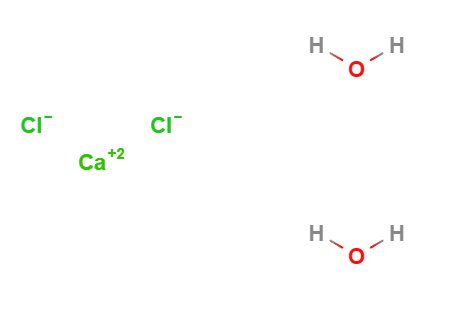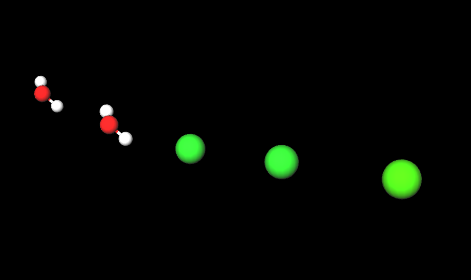| "Descrizione" by admin (19549 pt) | 2025-Jan-04 18:44 |
Calcium Chloride Dihydrate is a crystalline compound widely used in medical, pharmaceutical, cosmetic, and industrial applications due to its hygroscopic and stabilizing properties. It serves as a source of calcium ions, a stabilizer, and a desiccant in various formulations. Its solubility in water and compatibility with other ingredients make it a versatile and essential component in multiple industries.
Chemical Composition and Structure
- Calcium chloride is a neutral ionic compound composed of calcium ions (Ca²⁺) and chloride ions (Cl⁻).
- The dihydrate form includes two molecules of water of crystallization, enhancing its solubility and stability.
Physicochemical Properties
- Appearance: White, odorless crystalline powder or granules.

- Molecular Weight: 147.01 g/mol.
- Solubility: Highly soluble in water (74.5 g/100 mL at 20°C) and moderately soluble in alcohol.
- pH: Typically 4.5–9.0 in a 5% aqueous solution.
- Hygroscopicity: Strongly hygroscopic, absorbing moisture readily from the air.
Production Process
Raw Material Sourcing:
- Derived from natural brines or as a by-product in the production of soda ash (Solvay process).
Purification:
- Impurities are removed through precipitation and filtration.
Crystallization:
- Calcium chloride is crystallized with two water molecules to form the dihydrate.
Drying and Packaging:
- The crystalline product is dried under controlled conditions and packed to maintain its hygroscopic properties.
Applications
Medical Applications
Electrolyte Replacement:
- Used in intravenous solutions to treat hypocalcemia, cardiac arrest, and hyperkalemia.
Hemostatic Agent:
- Aids in blood coagulation and is used in some surgical applications.
Dialysis Solutions:
- Included in hemodialysis and peritoneal dialysis formulations to balance calcium levels.
In eye drops, it can serve various purposes:
Electrolyte Support
- Calcium is an important mineral for various cellular processes, including the proper function of corneal epithelial cells. When added to the formulation, it helps maintain an ion balance similar to that naturally present in the eye.
Osmolarity Control
- Like other salts (e.g., sodium chloride, potassium chloride, etc.), calcium chloride helps regulate the concentration of solutes in the solution. Proper osmolarity is crucial for avoiding eye irritation or dryness.
Formulation Stability
- The presence of calcium ions can contribute to the overall stability of the eye drop solution, helping ensure that the other ingredients remain effective and that the solution retains its physical and chemical properties over time.
In short, calcium chloride dihydrate is used in ophthalmic drops to closely mimic the composition of the eye’s natural fluids, reduce irritation, and promote the health and hydration of the ocular surface.
Pharmaceutical Applications
Stabilizer:
- Ensures stability in injectable solutions and other pharmaceutical products.
Calcium Supplement:
- Included in oral tablets or syrups for calcium supplementation.
Cosmetic Applications
Skin Conditioning Agent:
- Enhances skin hydration and elasticity when included in lotions and creams.
Stabilizer:
- Prevents ingredient separation in emulsions.
Industrial Applications
Desiccant:
- Used to remove moisture in drying applications.
De-icing and Dust Control:
- Commonly used in road maintenance to lower the freezing point of water and control dust.
Food Additive (E509):
- Acts as a firming agent in canned vegetables and as a calcium source in fortified products.
Environmental and Safety Considerations
Environmental Impact:
- Considered safe and eco-friendly when used appropriately; excessive use can affect soil and water salinity.
Safety Profile:
- Non-toxic when used within recommended concentrations.
- May cause skin or eye irritation; proper handling is required.
Storage and Handling:
- Must be stored in airtight containers to prevent moisture absorption.
Conclusion
Calcium Chloride Dihydrate is a versatile and indispensable compound with wide-ranging applications in medicine, pharmaceuticals, cosmetics, and industry. Its hygroscopic nature, high solubility, and role as a calcium ion source make it a valuable ingredient across various fields.
 |  |
Molecular Formula CaCl2H4O2
Molecular Weight 147.01 g/mol
CAS 10035-04-8
UNII M4I0D6VV5M
EC Number
Synonyms:
Calcium chloride 2-hydrate
Bibliografia__________________________________________________________________________
Leoci R, Aiudi G, Silvestre F, Lissner EA, Marino F, Lacalandra GM. A dose-finding, long-term study on the use of calcium chloride in saline solution as a method of nonsurgical sterilization in dogs: evaluation of the most effective concentration with the lowest risk. Acta Vet Scand. 2014 Oct 14;56(1):63. doi: 10.1186/s13028-014-0063-1.
Abstract Background: Canine overpopulation is a global issue with serious health and welfare implications. Nonsurgical methods of sterilization could yield positive impacts on this problem, but no long-term data on such methods are available. The objective of the current investigation was to determine the effects of intratesticular injections of calcium chloride dihydrate (CaCl2) in saline in dogs over a one year period. Five concentrations (0%, 10%, 20%, 30%, 60%) of CaCl2 in saline were administered via intratesticular injection to groups of 10 dogs each. Total sperm count and motility, blood levels of testosterone, and side effects were examined at 0, 2, 6, and 12 months post-injection (PI). Testicular size and semen volume were examined at 0 and 12 months PI. Results: Total sperm count, semen volume and testosterone showed significant dose-dependent decreases upon treatment with 10%-60% CaCl2 compared with either the control group (0% CaCl2) or baseline for each treatment group. Azoospermia was achieved for at least 12 months PI in 60% and 80% of treated dogs after administration of a 10% and 20% CaCl2, respectively. Treatment with 30% or 60% CaCl2 resulted in azoospermia in 100% of dogs, but more side effects were observed, while no side effects were noticed at lower doses. For each treatment group, testosterone levels had decreased an average of 35%-70% at 6 months following treatment. However, testosterone levels rebounded by the 12-month time point in all groups except the highest dosage group (60% CaCl2), which remained at the low end of physiological range throughout the study. Sperm motility dropped to zero or near zero in all dogs treated with CaCl2. Testicular size was significantly smaller at 12 months PI for all groups when compared to baseline. Conclusions: This first long-term study confirms reports of the efficacy of CaCl2 sterilization. However, at dosages free of adverse events, calcium chloride in saline may not provide permanent sterilization as previously believed. Future work should explore optimized solvents to increase the permanence of the well-tolerated 20% formulation.
Vieira LG, Hernandez O, Ribeiro JL, Cousson A, Kiat JM, Chaves MR, Almeida A, Klöpperpieper A. Structure of the X-phase of 38% brominated betaine calcium chloride dihydrate. Acta Crystallogr B. 2001 Jun;57(Pt 3):296-302. doi: 10.1107/s0108768101001525.
Abstract. The structures of the high- and low-temperature phases of 38% brominated BCCD [betaine (trimethylammonioacetate) calcium chloride dihydrate], the latter being known as the X-phase, have been determined by single-crystal neutron diffraction at 295 and 20 K, respectively. The symmetry of the X-phase is described by the P2(1)2(1)2(1) space group. The distortion with respect to the high-temperature Pnma phase is characterized by anti-symmetric displacements of the betaine molecules as well as of the Ca octahedra. On the basis of a symmetry-mode analysis, we propose an interpretation of the direct phase transition that occurs around 80 K between these two phases
Popkiss S, Horta F, Vollenhoven B, Green MP, Zander-Fox D. Calcium chloride dihydrate supplementation at ICSI improves fertilization and pregnancy rates in patients with previous low fertilization: a retrospective paired treatment cycle study. J Assist Reprod Genet. 2022 May;39(5):1055-1064. doi: 10.1007/s10815-022-02407-1. Epub 2022 Mar 9. PMID: 35262809; PMCID: PMC9107552.
| Evaluate |

